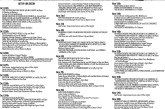
by Molly Lamb
Let’s start with a history lesson, dear readers.
In 1979, President Jimmy Carter legalized homebrewing in the U.S. Making any sort of alcohol at home used to be slightly frowned upon due to Prohibition-era laws. The fact that beer is lower in alcohol than other alcoholic beverages swayed the decision. The lower ABV allowed this legislation to pass because of the assumption that it likely would negatively affect social activities less and result in fewer adverse health consequences. (I guess these lawmakers never went drinking at a craft-beer bar on a UT game day.)
The legalization of homebrewing allowed many Americans to expand their creativity from simply exploring beers on flight boards at local taprooms to taking it into their own hands by concocting recipes to share with friends and family. Without the legalization of homebrewing, we wouldn’t see nearly as many craft breweries as we do today. This is simply because brewing equipment is extremely expensive. Allowing individuals to homebrew on a small, less expensive pilot system provides the opportunity to hone their craft before investing tens of thousands of dollars on equipment for larger-scale use.
All the new activity in the homebrewing scene led to beer competitions being established all over the country. These competitions are led by a panel of judges who use their discerning palates to understand, contemplate and rate these malt and hop-driven fizzy beverages. Judges taking their roles seriously in an effort to guide and encourage beermakers – from amateurs to professional brewers – is creating a landscape of creativity and hope in the craft-beer world. In short, beer judges exist to embolden the work of brewers on every level.
I had a great interview with George Talley, a local beer judge here in Knoxville. Here’s our conversation:

BLANK Newspaper: What’s your craft-beer origin story?
George Talley: I began working in beer in 2013 when I became a bartender at Suttree’s Tavern in downtown Knoxville. Being in the position of serving many different esoteric beers – no macro domestics or imports – it was necessary for me to learn as much as I could about what I was working with. The model for the bar was always that, if we went through a keg, there would be a new beer behind it, and we were usually only working with 1/6 bbl kegs (about 20L). This meant that 24 taps on a busy night might pour as many as 40 different beers of any various styles. Being passionate about flavor and the sensory experience made it easy to fall in love with beer, and I tripped headfirst into what was at the time the first shadows of the modern craft-beer culture.
At the time, American craft beer was at a point in its history where no one was really sure what was going to happen, but looking back, it’s clear that it really was the beginning of a renaissance. It’s difficult to fathom these days how little selection we had even 10 years ago – both because of the scale of many breweries at the time as well as more restrictive legal structures surrounding alcohol sales. In 2013, there were about 1,500 breweries throughout the U.S. including on-site service brewpubs. That number seemed astronomical at the time, and we were already starting to be concerned with whether or not the industry could support any more breweries. As of today, there are almost 10,000 breweries in the U.S., so I guess we learned the answer to that question.
BN: How does one become a certified beer judge?
GT: While studying to be a Cicerone, I discovered the Beer Judge Certification Program, which is a part of the American Homebrewers Association. Not that I didn’t appreciate or value the holistic approach to beer education that the Cicerone program offered, but I found a purity in the methods and guidelines that the BJCP uses for sensory assessment and chose to focus my studies solely in this realm. In 2015, I passed my preliminary exam and in January 2016 passed my tasting exam, officially becoming a certified beer judge.
To become a judge, first you’ll have to take an entrance exam, which is administered online. If you pass, you will be qualified to sit for your tasting exam, which must be administered in person. Sitting for that exam without having participated in at least one judging session at a local homebrew competition is just throwing money away; I highly suggest you look at the BJCP website for the competition calendar, as well as looking at its schedule of training courses and exam dates.
BN: What are the main categories of beer styles, and what are the key differences between them?
GT: Most of the primary categories in beer styles are in reference to place of origin, such as brown British Beer, Belgian ale and strong American ale. This is, however, not in reference to specifically where the beer is made, as is the case with wine. Rather, the flavors of a good example of the style should reflect the flavors common to beers historically made in those areas. Currently, there are 35 recognized categories encompassing 128 individual styles of beer, from American light lager to Piwo Grodziskie to experimental beer.
All beers have about four sources of flavor: water, hops, grains (usually malted barley) and yeast. The way that the brewer chooses to utilize each of these ingredients in concert with the others is what gives the final product its characteristics. Using darker malts creates darker-colored beer; more characterful yeast can lead to all sorts of extra spicy, fruity and floral aspects; lots of hops added during the boil can produce intense bitterness; poorly filtered water makes gross stuff.
BN: What are some tips for pairing beer with food?
GT: If I were to give one big tip when pairing food and beer, it would be to always remember that the carbonation accentuates aromatics and, along with the bitterness, will increase the perception of spice. Calm down with those IPA and hot-wing pairings! I guess that’s not a tip, it’s a pet peeve.
Don’t treat the beer as a subject to be framed but as an element in the flavor; the same with the food. Here’s a simple pairing that you can try: a good roasty German Schwarzbier and a triple-creme brie cheese. Add them together: grilled cheese sandwich. The Schwarzbier offers similar roast levels to what you would find in an English porter or American brown ale, but as a lager is lighter and drier than either, letting the natural gentle sweetness of the cheese play its part.
BN: What are the key criteria used to evaluate a beer?
GT: The aspects of a beer that we assess are aroma, appearance, flavor and mouthfeel. These scores are weighted, with the most possible points in flavor, followed by aroma, then mouthfeel, then appearance. We score against the style that the beer was submitted under; the world’s most divine Belgian quad will score very poorly if it is assessed as a cream ale. This is why it is also important for homebrewers to study the style guidelines.
It’s worth noting that we are not assessing from a place of personal preference, but to answer how well the beer fits the proposed style. There are points available to give for the overall impression, which is where a judge might suggest process changes, a better category fit or structural elements to adjust the balance to improve the beer.
BN: What are some common mistakes that homebrewers make?
GT: Opening breweries! But seriously, overambition is the death of any hobbyist. If you want to learn about building codes and employment law, open a brewery. If you want to make beer and hang out with your friends, just do that. It doesn’t have to be complicated.
Also, learn to make the best beer you can with the equipment you have. Become really great with the equipment you have until it truly is the equipment that’s failing you. Not sure what’s going wrong? Go to your local homebrew club and enter your beer in competitions. You might get some harsh critique, but judges are trained to give process-related feedback, and they might see something you didn’t realize was right in front of you.
BN: What is your favorite beer style currently, and why?
GT: I’m always down for any sort of malty lager or English ale. Easy drinking, flavorful, pairs great with whiskey!
BN: What is the most challenging aspect of being a beer judge?
GT: Palate fatigue and allergies can turn an otherwise relaxing and fun experience into a pretty frustrating day. As tempting as it is to volunteer for extra sessions if there aren’t enough judges, it’s not always the best choice. It’s a judge’s responsibility to provide a service to the brewer submitting their beer, and a good judge should want to give the best-quality feedback they can.
BN: What are some of the most common misconceptions about beer?
GT: Pilsners are a kind of lager, the same way that geese are a kind of bird.
“Lager” and “ale” functionally are referencing the kind of yeast used for fermentation. (Please don’t @ me about Kölsch.)
There are millions of beers out there; I promise you’ll like one. Don’t give up.
Don’t ever let anyone tell you you’re wrong for liking what you like! You’re who has to drink it after all.
Now that you’re in the know, take a second to appreciate all that goes into judging a beer. It’s more than just liking the product; it’s cultivating a palate that can truly delineate the characteristics of beer. It’s at this moment when one will learn beer is a whole world of sensory experiences.
Until next month, drink local, tip your bartender and stay “Tapped in,” Knoxville.
-Molly • craftbeerclass@gmail.com







